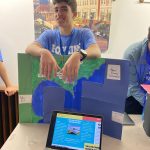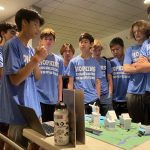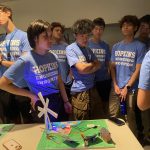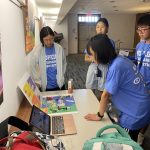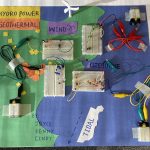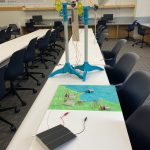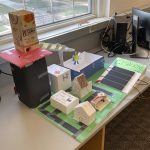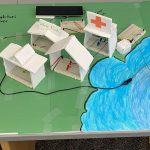The Sustainable Energy Engineering (SEE) Program, a summer experience designed to help high school students learn about sustainable energy engineering, can best be described as a crash course. Hosted by the Ralph O’Connor Sustainable Energy Institute (ROSEI) and offered through the Whiting School of Engineering’s Engineering Innovation (EI) program, the program covered a wide range of topics in four weeks this summer.
In its inaugural year, spanning the month of July, the program achieved remarkable success, according to Rachel Sangree, an associate teaching professor of civil and systems engineering who also serves as an associate researcher with ROSEI and co-developed the curriculum.
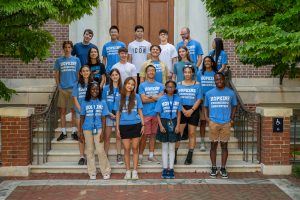
SEE Students from the Hopkins Contingent
“The key was finding the right teachers to educate the students and both Victoria Ding and Marie Harold fit the bill perfectly,” Sangree said.
Ding, a doctoral candidate in the Department of Civil and Systems Engineering, headed up the Homewood campus section of the program, with Harold spearheading the Hood College program site in Frederick. Harold, a former Department of Defense aerospace engineer, currently teaches physics at Frederick County Public Schools and previously taught at Towson University.
Sangree acknowledged that no single teacher could be expected to be an expert in all the topics covered in this course, from circuits and hydropower to transportation policy and building material R-values. “The important thing—and what we were fortunate to find—was that they have expertise in key areas of sustainable energy engineering and the curiosity and excitement to learn more and pass their knowledge on to the students,” she said.
“The students we had this year shared that passion, which made it easy to teach. They wanted to be there and learn,” Ding said. Students said that along with providing them with an overall understanding of different types of sustainable energy, the program’s hands-on projects were especially worthwhile and enjoyable.
In an anonymous post-program survey, one student wrote “What I liked best about SEE was the labs that kept us engaged and encouraged teamwork with our group members.” Another highlighted the effectiveness of the program’s schedule, noting “I liked that every day had an interactive lab; it was good to learn in the morning and implement the skills in the afternoon.”
Now that the first year is in the books, Sangree and Claire VerHulst, Engineering Innovation program manager and the curriculum’s co-developer, are evaluating opportunities to enhance next year’s program. “We look forward to engaging even more with the dynamic economic, social, and political aspects of sustainable energy so students develop a deep understanding of the real-world context to complement their technical studies,” VerHulst said.
The group is also exploring the feasibility of expanding the program. In its initial year, 40 students participated across both sections. Next year, the program directors aspire to broaden its reach by offering the curriculum at more colleges, with a long-term goal of offering it remotely. For that reason, the success of the Hood College section was particularly exciting for VerHulst.
“Both sections went so well, but I am particularly encouraged by the tremendous success of the Hood program because it shows the curriculum can thrive away from a Hopkins campus,” VerHulst said. “Our goal is to offer the course online and at in-person locations across the country, so every eligible student has an opportunity to participate. We got great feedback from this year’s students, and I have no doubt that more high school students would find SEE to be a valuable experience.”
SEE is also seeking external partners from industry to become part of the program. Ben Schafer, ROSEI’s Director, envisions the opportunity for their involvement through initiatives such as establishing scholarships or inviting their experts as guest lecturers. The hope is that these partnerships would both expand the scope of the program and make it more accessible to any student.
“The first year of our SEE program for high school students was a great success,” Schafer said. “Educating future innovators and leaders in sustainable energy is a core aspect of ROSEI’s mission, and this curriculum does an excellent job of providing a leaping off point for the next generation to begin their journey to help us all through the energy transition and combatting climate change. We hope that others will see the value of this effort and want to help any student get involved, regardless of background.”
The photos listed below are courtesy of Patrick Greene, and are of the Hood College section of SEE.
